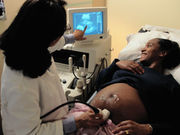Specifically, fractional thigh volume better than two-dimensional biometry
MONDAY, Oct. 9, 2017 (HealthDay News) — Fractional thigh volume measurements improve detection of late-onset fetal growth restriction, compared to two-dimensional biometry, according to a study published in the October issue of the American Journal of Obstetrics & Gynecology.
Louise E. Simcox, M.B.Ch.B., from the University of Manchester in the United Kingdom, and colleagues derived normal values for three-dimensional fractional thigh volume in the third trimester. Prospectively, the authors evaluated 115 unselected pregnancies using both standard two-dimensional ultrasound biometry measurements and fractional thigh volume measurements.
The researchers observed a better correlation between fractional thigh volume and estimated fetal weight obtained at 34 to 36 weeks with birth weight, compared to two-dimensional biometry measures such as abdominal circumference and estimated fetal weight. Fractional thigh volume-derived measurements also modestly improved detection of both small for gestational age and fetal growth restriction, compared to standard two-dimensional measurements (area under receiver operating characteristic curve, 0.86 and 0.92, respectively).
“Fractional thigh volume measurements offer some improvement over two-dimensional biometry for the detection of late-onset fetal growth restriction at 34 to 36 weeks,” the authors write.
Copyright © 2017 HealthDay. All rights reserved.








